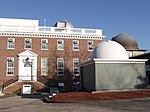Smithsonian Astrophysical Observatory

The Smithsonian Astrophysical Observatory (SAO) is a research institute of the Smithsonian Institution, concentrating on astrophysical studies including galactic and extragalactic astronomy, cosmology, solar, earth and planetary sciences, theory and instrumentation, using observations at wavelengths from the highest energy gamma rays to the radio, along with gravitational waves. Established in Washington, D.C., in 1890, the SAO moved its headquarters in 1955 to Cambridge, Massachusetts, where its research is a collaboration with the Harvard College Observatory (HCO) and the Harvard University Department of Astronomy. In 1973, the Smithsonian and Harvard formalized the collaboration as the Center for Astrophysics | Harvard & Smithsonian (CfA) under a single Director.
Excerpt from the Wikipedia article Smithsonian Astrophysical Observatory (License: CC BY-SA 3.0, Authors, Images).Smithsonian Astrophysical Observatory
Martin Street, Cambridge
Geographical coordinates (GPS) Address Nearby Places Show on map
Geographical coordinates (GPS)
| Latitude | Longitude |
|---|---|
| N 42.38146 ° | E -71.12837 ° |
Address
Harvard University
Martin Street
02138 Cambridge
Massachusetts, United States
Open on Google Maps











